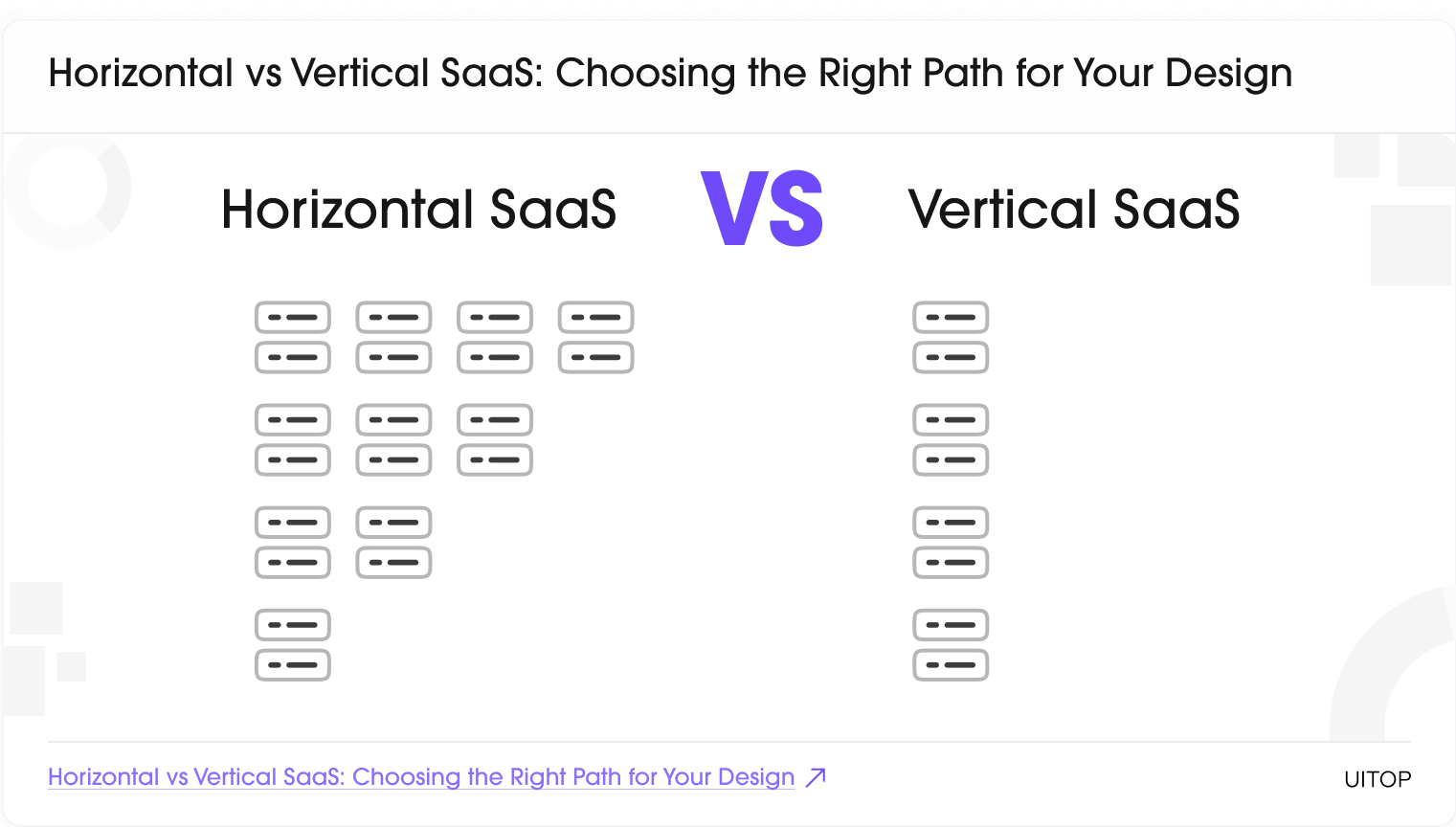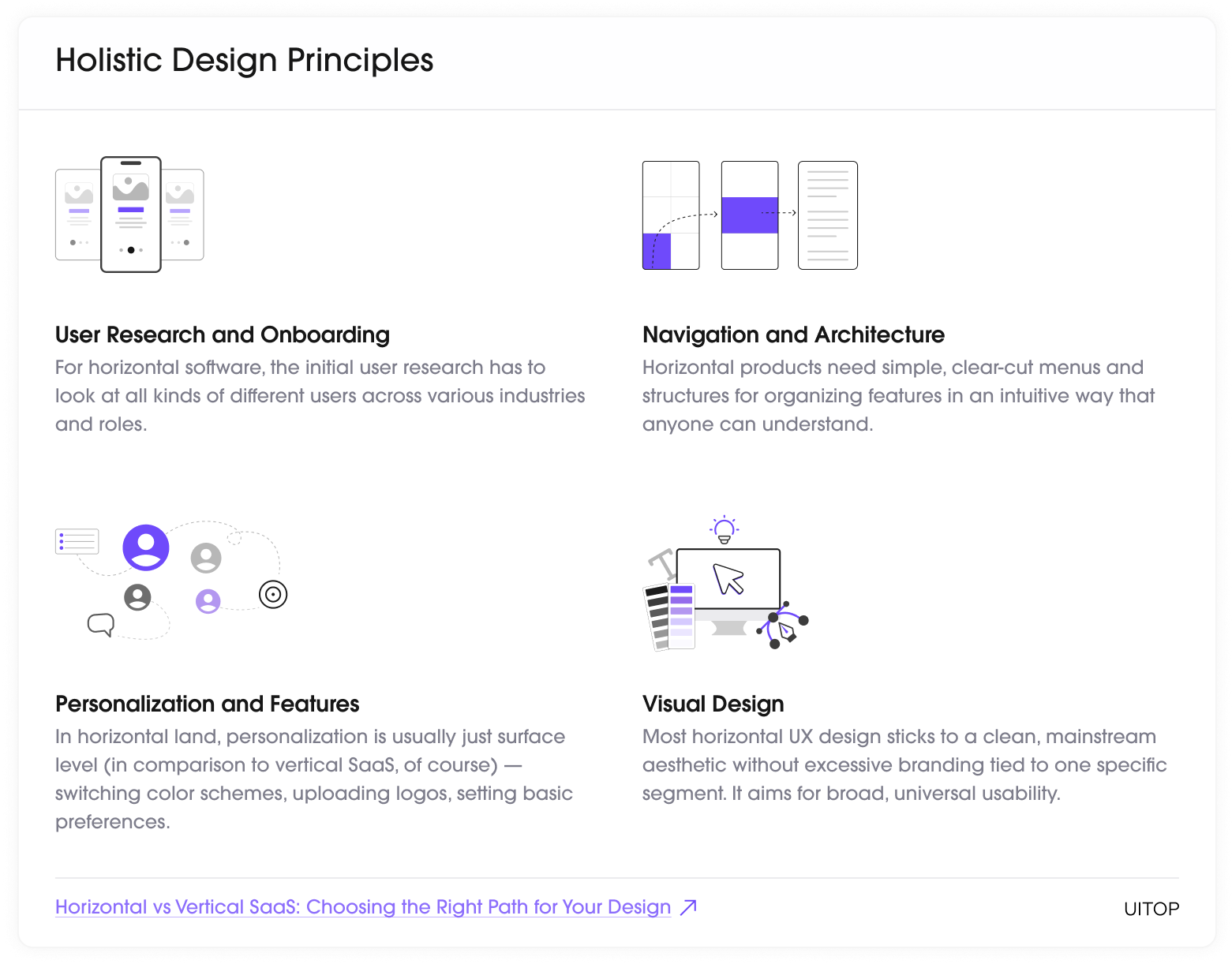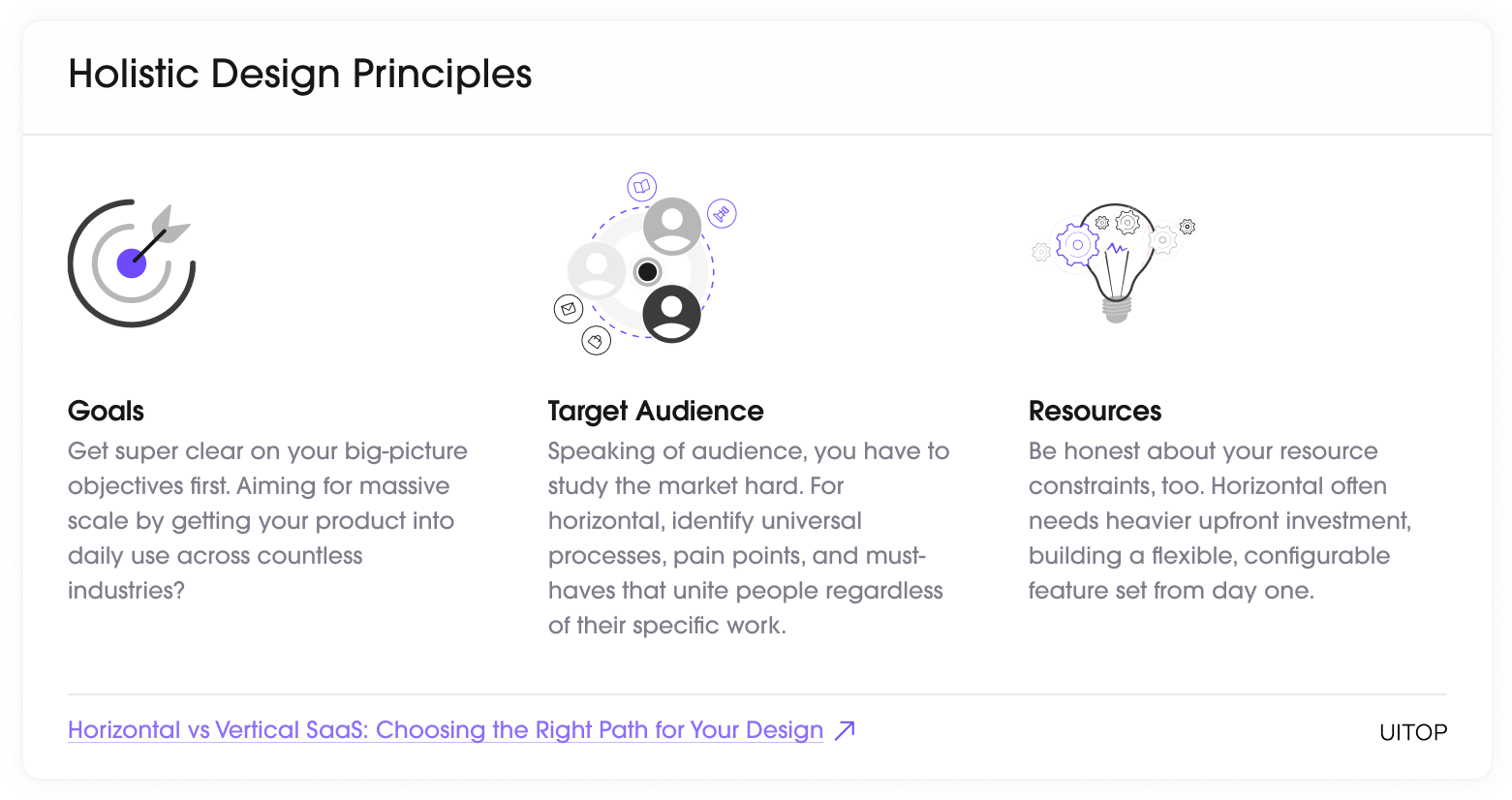What is SaaS?
If you're just beginning to research the idea of SaaS, this is the place to understand what SaaS can accomplish for you, how it works and differs, what are the main examples and what the future holds for SaaS development.
When creating SaaS products, there are basically two paths you can take — going wide or going deep. Horizontal SaaS means your software works for all sorts of customers across different industries. It’s trying to be a one-size-fits-all deal. In contrast, vertical SaaS is focusing on one particular industry and customizing for its needs
These two paths require different design approaches. For horizontal SaaS, the design needs to be flexible so it can adapt to whatever a customer needs, no matter their industry. But for vertical software, you need to understand that one industry inside and out. The design should directly fix the issues those customers run into day-to-day.
This article explains the big design differences between horizontal apps for various industries and vertical apps laser-focused on a single market. Discover why research, menus, features, and branding change a lot for wide or narrow audiences.

As we’ve mentioned, horizontal SaaS products appeal to a wide range of users across different industries. These cloud software apps offer general features that could benefit all kinds of potential customers.
For example, tools like Google Workspace, Slack, or Trello get used in organizations of all sizes and sectors. Their capabilities are broad and flexible enough to be useful for marketers, engineers, sales representatives, and more.
Creating something that many people can actually use is hard. The design must walk a tightrope – strong enough for experts but still simple for newbies. Too many bells and whistles can make it feel bloated if you just need something basic.
Horizontal SaaS designers should also figure out what improvements matter to everyone. If one customer group asks for some specific workflow, that might not be worth the effort because it only helps that one group. So, designers have to prioritize changes that benefit the whole pack of users.
On the other hand, a wide appeal gives horizontal apps access to massive potential markets. Everyone needs basic productivity, communication, and collaboration tools. An ingenious horizontal product can quickly capture a huge global scale by inserting itself into the day-to-day modern work experience.
Let’s check out some big-name examples to better understand the horizontal SaaS concept. Salesforce and Dropbox — we’re sure you’ve heard of them:
Basically if you want to go horizontal, you can’t get too specialized or complex. Your product must be configurable, so each customer can tweak it to what they need.
Vertical SaaS software is about specialization. Instead of trying to be useful for all types of businesses, it zones in on just one specific industry or function.
The vertical software must be carefully designed around the unique day-to-day realities of a single domain. Everything, from the features to the user interface to the terminology, should be molded precisely for the target audience.
For instance, let’s say it’s vertical SaaS for healthcare providers. So you’d see capabilities built-in for aspects like managing patient records, handling prescriptions, tracking regulatory rules, and visualizing relevant medical data and metrics. The entire experience speaks the language and workflow of healthcare.
The niche specialization is a double-edged sword, though. On the plus side, it allows the software to seamlessly slot into and optimize the intricate processes of the one vertical. But the downside is it boxes the vendor into a limited market segment.
Let’s look at some well-known examples that focus on specific industries and jobs:
In each case, the vertical approach means scrutinizing the distinct processes, terms, roles, and metrics that separate one niche industry from all others.
The choice between a horizontal or vertical approach for your SaaS product shapes the whole user experience from start to finish.

For horizontal software, the initial user research has to look at all kinds of different users across various industries and roles. You can’t just focus on one specific type of customer. You have to spot common pain points and needs that pretty much everyone shares, regardless of their line of work.
“What issues are common to finance teams, operations teams, marketers, and other teams as well?” That’s what horizontal research tries to identify. Then, when new users sign up, the onboarding process walks them through customizing the general tool to their own situation and preferences.
But vertical user research allows you to go deep into the specifics of just one singular industry. Then onboarding gets your niche users up and running seamlessly by using the terms, UI flows, and guidance they already know, like the back of their hand from years in that field.
Horizontal products need simple, clear-cut menus and structures for organizing features in an intuitive way that anyone can understand. The navigation labels and sections should follow familiar mental models about separating communication tools, file management, reporting, and so forth into distinct, easy-to-grasp categories.
A vertical product, though? It can use the industry’s actual jargon and concepts as the navigational roadmap. And the overall architecture follows the specialized roles and workflows unique to that niche. Medical software could have dedicated areas for “Clinical Trials,” “Regulatory Compliance,” and “Drug Supply” that’d make no sense for broader tools.
In horizontal land, personalization is usually just surface level (in comparison to vertical SaaS, of course) — switching color schemes, uploading logos, setting basic preferences. But the core features themselves remain pretty uniform to stay relevant for any customer.
These products avoid over-customizing any one feature set, as that could alienate other audiences. You get a wide-ranging toolkit that’s definitely configurable but still operates at that general level.
As for vertical solutions, they personalize based on each customer’s bespoke roles, compliance rules, and processes within that industry. Entire features get tailored to specialized workflows.
Like medical software baking in personalized processes for HIPAA privacy rules.
Most horizontal UX design sticks to a clean, mainstream aesthetic without excessive branding tied to one specific segment. It aims for broad, universal usability.
Vertical products can absolutely incorporate distinct colors, layouts, icons, and branding elements that make the experience unmistakably resonate with that particular industry’s look and feel. It breeds instant familiarity.
For example, a vertical SaaS for restaurants might use textured backgrounds reminiscent of brick or wood along with iconography of chef’s knives, forks, and plates to create a look that resonates with the hospitality industry’s aesthetic.
The right approach depends on factors like your specific goals, target audience, and resources you’ve got to work with. Let us walk through a straightforward framework to help you evaluate the choice.

Get super clear on your big-picture objectives first. Aiming for massive scale by getting your product into daily use across countless industries? Horizontal may be the play for the widespread ubiquity and enormous market potential.
But if your end game is building the absolute best solution for one particular industry niche, vertical lets you laser in on checking every box for that segment’s specialized needs. No compromises.
Speaking of audience, you have to study the market hard. For horizontal, identify universal processes, pain points, and must-haves that unite people regardless of their specific work. What commonalities span industries?
Vertical? You can go deep researching the details of one specialization area. Just be sure the total revenue opportunity in that singular domain is viable long-haul.
Be honest about your resource constraints, too. Horizontal often needs heavier upfront investment, building a flexible, configurable feature set from day one. Vertical solutions can start leaner for an initial niche. But scaling eventually forces rebuilding and expansion into new verticals.
Don’t overlook human resources, either. Horizontal design teams generalize for any use case. Vertical means finding legit niche expertise or training it up internally.
Ultimately, the horizontal versus vertical decision goes beyond just market size or required features. It’s a philosophical choice about the fundamental relationship you want your SaaS product to have with its users.
Whatever way you want to go, Uitop, a SaaS design company, can help you. We have experts good at creating top-level designs that work well for everyone and can be used all over the world. We also provide teams that specialize in different industries with a deep understanding of the specific details within fields such as healthcare, construction, law, accounting, and more.
Reach out today, and let’s explore aligning your SaaS design with your strategic aspirations.

Horizontal SaaS products are created to serve many industries and have general features that can be adjusted for different uses. Vertical SaaS products focus on a single industry, customizing the software for the special requirements and processes of that particular sector.
Usually, horizontal products demand extensive early user research to grasp similarities among varied customer groups. Vertical research can go deeper into one specialized industry.
Vertical SaaS allows for deeper customization because it’s possible to adjust features specifically for the unique positions, regulations, and workflows of a particular industry sector. Horizontal personalization is usually more surface-level.
Evolving from vertical to horizontal, or vice versa, requires a major redesign of the product. For a vertical app expanding into new industries, you essentially have to rebuild the UI, navigation, features, and branding from scratch to properly align with each new niche’s distinct processes and needs. Similarly, making a horizontal app vertical-specific means overhauling the design to deeply specialize the experience for that one industry.
If you're just beginning to research the idea of SaaS, this is the place to understand what SaaS can accomplish for you, how it works and differs, what are the main examples and what the future holds for SaaS development.
The software landscape has fundamentally shifted. Gone are the days of clunky desktop applications and on-premise servers. SaaS now dominates, offering always-on, highly scalable solutions accessible from any device. Understanding the diversity of SaaS solutions available and the unique needs of users across products is imperative. This overview highlights key SaaS software categories relevant to […]
A successful user journey is one that ends with a purchase. That is why marketers dedicate a lot of resources to getting them through all the steps. However, the whole effort can be in vain if the software-as-a-service (SaaS) pricing page design is built incorrectly. And some of the companies, namely 60% of the research […]
“They took extra time to ensure that our frontend developer could easily implement the wireframes.”


Our processes with your needs in mind drives any SaaS product growth. Let’s see how our approach aligns with your vision.
Let’s discuss your design challenges
Please leave your email so we can contact you

Tell us a little more about your product so we can estimate it
We'll help you make the right choice!
Leave your email to receive regular updates to your inbox